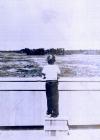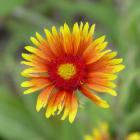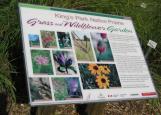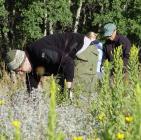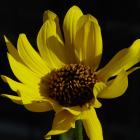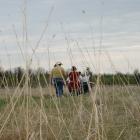1
Start of 16: Current Efforts in Prairie Preservation: Marion Graham3
We went then to this uncultivated field on Saskatchewan between Sturgeon Road and Moray ah and immediately west of the railway track and we got ah, you know, we just sort of got out of the car and found that there were many many crocus. Many crocus. So again, of course, we picked bouquets. What else would you do but pick bouquets? And we came back with the children until they, our children came back you know, they probably brought their boyfriends and girlfriends at one point, coming back, that's how long we returned. Then I think that would have been between 1985 maybe and 1990, early '90's. I'm not sure when. We came and found, to our horror, that the field had been disturbed by machinery. I'm not sure of this, possibly that whole property was owned by Boeing and ah, I know that when we were picking crocus we could see the Boeing plant through the trees quite easily, the back of it and there may have been some plan to use that field, you know at that time, and the field was disturbed in any case and there were no crocus. And none at all, we found practically nothing there, it was just a, a, you know, a wasted area. And ah, we returned another year and again nothing. And so it was very sad and we wished we had known more that we might have done something to protect it and ah then we didn't return again.5
We wanted this to happen and we became active. The first year planning only. Because we wanted things to be planned right, you know? And for it to be a success if we were doing it. I had originally had in mind a very small, tiny, little garden with some wildflowers (laughing). The whole idea of some wildflowers was all I was really considering. So when we met with Cheryl at the park, in the parks office, she said there's a, there's an area of the park that has been suggested that we might be able to use. And we went out to what had been the tree nursery, and she somehow was in touch, I think maybe on cell phone even then, or from the office, and they said yes, we've decided that we would let you use that for your wildflower garden. Well, we were astounded, but we were so ignorant that we didn't know that the bigger the area - 'cause this was a big area - the more work. We still were naive; we thought we were still the planners. And, that was the first year. And the Naturalist Office drew up a plan, we thought that was very nice and pretty with the paths wandering through. And we knew what we wanted. We wanted for children in particular, but for all citizens, to be able to come through and see wildflower gardens with a little bit of grass. A little bit of ornamental grass to set them off and maybe some small grassy areas. But our original idea was gardens of wildflowers and that was planned in the, in the King's Park Wildflower Garden there were areas surrounded by large rocks that were designated flower gardens. There were other little areas that were designated as flower gardens with some grasses, you know ornamental grasses too. The other areas were seeded to grass and some wildflowers, in 1965 [should be 1995] that planting took place. Probably ah, for our vision the plan was in error. But, I don't think anybody quite knew this, this was pretty experimental anyway, this revegetation there, restoration of ah, you know it became a restoration. That wasn't our original thought. It's our, it's our pride now. But we've gone through a lot of change in our thinking. And we also knew that we wanted school children involved. It was very important to us that this garden be there for children, that it be welcoming to children and that children participate if this is practical. And it turned out that in 19, in the winter of 1995 and in 1996 we were able to raise enough money to bring in a naturalist to speak with the children about the prairie and also help them along with the volunteers, the community volunteers, to germinate seed that they would grow and then plant with us in the spring of 1995 and again repeated this same thing again in 1996.7
But gradually, the garden took its own shape, and it wasn't, weeding wasn't required. We had one of our, of our volunteers who also, well, I'll come to that in a minute, she did the sketching, used to go out every spring and sometimes we were there with her, but often she would just go ahead and do it and took down all the dead stuff. All the dead growth and cleaned out - sometimes there'd be 17 bags of dead growth to clean up, so the garden was ready for people to see it more quickly. She did that up until this year. And, um, and it seemed to be okay without it, but I think we felt that that she was absolutely necessary. That it was necessary for her to do that for the garden to ever come along in the spring and summer. Mostly of recent years, the work has just been ah, making sure the, that the path was kept up and we haven't done any physical labour, other than the cleaning out of the dead stuff and of course the fires, the burns have been important too - there have been two I think, burns over the 10 years. One semi-, semi-successful, it didn't completely burn. The other, a little more. Um, what else can I tell you about that? The labelling has been important to us - very important, because we feel that the community walking through can see the signs - some of the pictures and so on, but to walk through, and then have a sign that says "THREE- FLOWERED AVENS", "oooh, that's three-flowered avens", they will say. And when we've been working in the garden over the years, and have had people come through, that's one of the things they have liked is to be able to know what they're looking at now. Many people have no idea what the flowers are, you know. And this is important to them.9
Julie Sveinson, who was in the City Naturalist office, was the first who called it a tall grass prairie restoration. And we said, "Oh, that's what it is now", you know sort of thing. But because she is so fond of a tall grass prairie restoration, and so enthusiastic about it, I think a lot of credit goes to her for us regaining, I don't, that's not the correct word, not to regain… How should I say it? That we were able to take on a new concept of the garden with pride. That it didn't have to be the way we had thought it was going to be. That it could, that it had become its own wonderful self, you know? And I think a lot of credit goes to Julie. Dr. Jennifer Shay also was respected enough in the community that when she said "It's wonderful, it's just, you know, it's wonderful", early on, very early in the stages of the garden, we realized it must have something. But, you know, we were busy sort of doing the, the weeding and the…All the leg work.
…and trying to get time, man hour time to keep up the path and to do the burns and to ah, discuss about the fence and the things that were practical and that that was something that had to be done too. And then Julie came along and was so enthusiastic that we felt almost as if there was a lot of reason to feel that the garden would be safe in her hands. If that makes any sense.
11
I hope it's sustainable. I hope it is. Now, it did take quite a dramatic turn, in it's own life and we discovered that it had it's own agenda - very strong own agenda. That after, well in 1997, there was the flood, and that garden was under about 3 feet of water for several weeks - at least three weeks. And it just remained under water. And we wondered if there would be anything at all when the waters receded. And we went in and of course there was little to see when we first took a look at this little garden. Not so little garden - it's about a ˝ acre. Approximately a ˝ acre is what we estimate. But that garden just came back, as it should have. A tall grass prairie restoration. Some of the flowers that might have might have lived if we had replanted, were gone. They had, they had rotted. Maybe at the particular time of the year that it hit them. Others, and certainly some areas of the garden - the flowers didn't live. For example, the three-flowered avens are living in one area only, where they were in different areas. And that's happened throughout the garden, that one area has them still but the other areas they're gone. We did replace with some plants again and a few of those have lived. Generally speaking, I would say that there are, year to year, there are about, I think this is, thirty-five to forty, I hope I'm accurate on this. I do have the numbers, if you want these. Thirty-five to forty different wildflower species there during the year and how many grasses was it? Eight prairie grasses? Nine prairie grasses?12
I planted that big bluestem1977
2795 Ness Ave, Living Prairie Museum, St. James, Winnipeg, Manitoba, Canada
